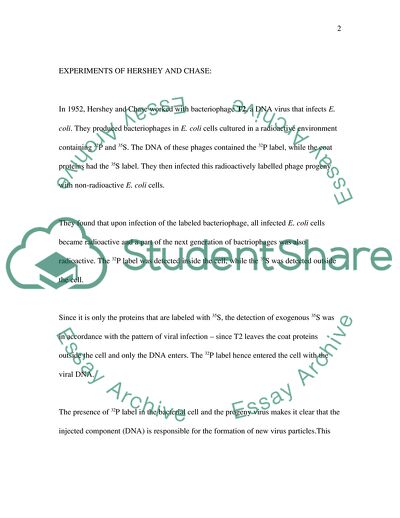
- Home
- Free Samples
- Premium Essays
- Editing Services
- Extra Tools
- Essay Writing Help
- About Us
- Studentshare
- Subjects
- Miscellaneous
- Describe following experiments & indicate how each provided evidence of how genetic material is copied and exchanged: Griffith and Avery-bacterial transformatio
Describe following experiments & indicate how each provided evidence of how genetic material is copied and exchanged: Griffith and Avery-bacterial transformatio - Essay Example
Heat inactivation of the strain…

- Subject: Miscellaneous
- Type: Essay
- Level: Undergraduate
- Pages: 4 (1000 words)
- Downloads: 0
- Author: maiabeier
Extract of sample "Describe following experiments & indicate how each provided evidence of how genetic material is copied and exchanged: Griffith and Avery-bacterial transformatio"
In 1944, Avery, MacLeod & McCarty attempted to determine exactly which component of the virulent strain was responsible of transforming the non-virulent strain into virulent. They separated lipids, polysaccharides, proteins, and nucleic acids and tested them separately for the ability to transform the non-virulent strain into virulent. They then inactivated RNA and DNA in separate experiments using RNases and DNases, and deduced that only DNA has the capability to transform the bacteria. In 1952, Hershey and Chase worked with bacteriophage T2, a DNA virus that infects E. coli. They produced bacteriophages in E.
coli cells cultured in a radioactive environment containing 32P and 35S. The DNA of these phages contained the 32P label, while the coat proteins had the 35S label. They then infected this radioactively labelled phage progeny with non-radioactive E. coli cells. They found that upon infection of the labeled bacteriophage, all infected E. coli cells became radioactive and a part of the next generation of bactriophages was also radioactive. The 32P label was detected inside the cell, while the 35S was detected outside the cell.
Since it is only the proteins that are labeled with 35S, the detection of exogenous 35S was in accordance with the pattern of viral infection – since T2 leaves the coat proteins outside the cell and only the DNA enters. The 32P label hence entered the cell with the viral DNA. The presence of 32P label in the bacterial cell and the progeny virus makes it clear that the injected component (DNA) is responsible for the formation of new virus particles.This provides a further proof that DNA is the genetic material governing the life-cycle of organisms.
Meselson and Stahl devised a strategy to distinguish between old and new DNA. They labelled the DNA with isotopes of nitrogen. The cultured E.coli cells in a radioactive environment containing heavy nitrogen (N15H4Cl).After 14 generations of the bacterium had passed, they abruptly
...Download file to see next pages Read MoreCHECK THESE SAMPLES OF Describe following experiments & indicate how each provided evidence of how genetic material is copied and exchanged: Griffith and Avery-bacterial transformatio
Meiosis; Asexual and Sexual Reproduction; History of Genetics;
Various Change Theories
Avery's Study and How It Changed Biology as We Know It
Bacterial Transformation
Bacterial Cell Surface Tension Attachment and Implications for Bioremediation
Bacterial Cell Surface Tension Attachment and Implications for Bioremediation
Successful Transformation of Bacterial Cells with Different Plasmid
The Processes of Bacterial Transformation

- TERMS & CONDITIONS
- PRIVACY POLICY
- COOKIES POLICY